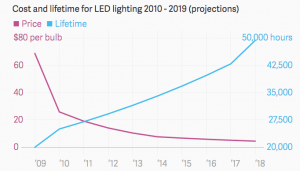
The light has gone off in Richmond Hill. This GTA town north of Toronto is converting most of its 17,000 street, park and parking lot lights to LED as part of a contract it has just signed with Ameresco, which will supply and install the new lights. But this is more than just about high-efficiency lighting. The town will be getting a “smart lighting control system” that allows staff to remotely monitor and turn off/on the lights.
Is it worth it? Hell, ya. LEDs consume up to 60 per cent less power than “high pressure sodium” lamps currently used in most infrastructure. The town is expected to spend around $8 million to convert 15,000 lights and in return will enjoy $1.5 million in energy and maintenance savings each year. We’re talking payback in about six years on lights that are warrantied to last for 20 years.
 And keep in mind, the price of LED lights have plunged by about 90 per cent since 2010, according to the U.S. Department of Energy. At the same time, efficiency and operating life continue to climb. Like solar and energy storage, the deal just keeps getting better and better.
And keep in mind, the price of LED lights have plunged by about 90 per cent since 2010, according to the U.S. Department of Energy. At the same time, efficiency and operating life continue to climb. Like solar and energy storage, the deal just keeps getting better and better.
The smart controls, which communicate with the lights through a wireless narrowband network, will also allow staff to more accurately monitor electricity consumption, dim the lights, and be notified when a bulb isn’t working properly.
“With this wireless network in place, Richmond Hill is one of the few Canadian municipalities to lay the foundation for high-tech systems management and is establishing the foundation for future ‘smart cities’ applications such as smart traffic lights, water and gas metering,” according to a town release.
Toronto Hydro has been testing the waters for LED street lighting, but the city has yet to dive in. Right now, about 150 LED street lights are being tested “in advance of a full citywide rollout,” but there’s no word on when that rollout is going to happen. Consider Toronto has 170,000 streetlights alone. Add in park and parking lot lights and it has a lot of work to do.
Aurora is taking the step, along with Markham, Newmarket and another 125 municipalities. The trend is taking hold, but seriously, there’s no compelling reason why this shouldn’t be a priority for every municipality in Canada. The financing models exist to ease the upfront capital costs. Municipalities just need to commit and do it.
And keep in mind, this is more than just about streetlights. Parking lots represent a massive opportunity. A December study from the Canadian Urban Institute estimated there are at least 42 million parking stalls in Canada. “Parking lots were estimated to have an average of one light per 20 stalls, and garages an average of one light per three stalls,” according to the report.
“Although there are more parking lighting fixtures in Canada than streetlighting fixtures, parking lighting only accounts for 5 per cent of LED sales,” it says. “This is likely because the sales process is more difficult with the more distributed ownership of the parking lighting, but this does not diminish the significant potential for improved safety energy and cost savings, GHG reduction across Canada.”
SOURCE: CLEAN | BREAK – Read entire story here.







